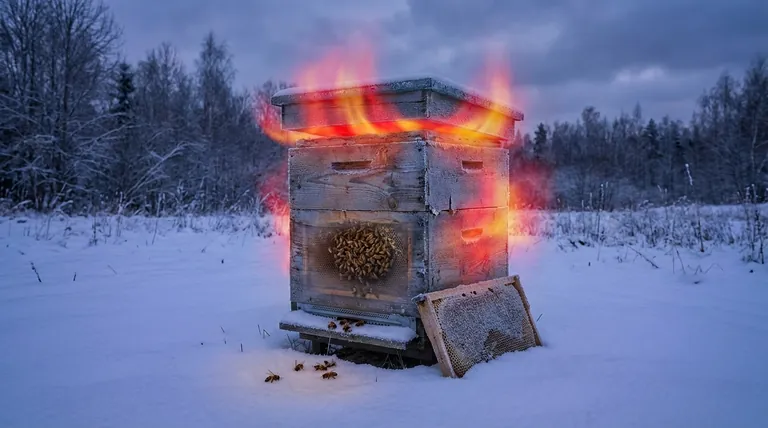Insufficient hive insulation has several critical negative outcomes, primarily centered on resource depletion and colony stress. The bees are forced to consume significantly more of their honey stores to generate heat, which can lead to starvation, increased stress levels, and higher winter mortality rates.
The core issue with poor insulation is that it forces a honeybee colony to divert its most precious resources—energy from honey and the labor of its workers—away from growth and survival and into a constant, losing battle against the cold.

The Core Problem: A Constant Battle Against Heat Loss
A honeybee colony's primary winter objective is to maintain the temperature of its central cluster, keeping the queen safe and ready for spring. Inadequate insulation makes this a far more difficult and costly task.
Increased Honey Consumption
Honey is not just food; it is the fuel a colony uses to survive the winter. Bees generate heat by shivering their flight muscles, a process that burns through their honey stores at a rapid rate.
An uninsulated or poorly insulated hive acts as a heat sink, constantly pulling warmth away from the cluster. This forces the bees into a state of continuous, high-energy consumption simply to maintain their core temperature, drastically depleting the food they need to last until spring.
Elevated Colony Stress
The constant fight against cold is a significant physiological stressor for the colony. This is not just a matter of comfort; it has tangible biological consequences.
Prolonged stress can weaken the bees' immune systems, making them more susceptible to diseases and parasites. It also shortens their individual lifespans, weakening the colony's overall strength and resilience.
Higher Mortality Rates
The combination of dwindling food stores and heightened stress directly leads to higher death rates.
Colonies can starve even with honey present in the hive if the cluster is too cold to move to a new frame of food. More commonly, the colony simply runs out of its fuel reserves long before the first spring nectar flow, leading to the entire colony perishing.
The Hidden Costs to Productivity
Beyond immediate survival, poor insulation creates secondary problems that undermine a colony's productivity and long-term health.
The Propolis "Tax"
Bees use propolis, a resinous plant substance, to seal cracks and drafts in their hive. While this is a natural and beneficial behavior, it becomes a problem when done in excess.
In a drafty, poorly insulated hive, bees will spend an enormous amount of time and energy gathering propolis and sealing every tiny gap. This labor comes at a direct cost, detracting from the time they could be foraging for nectar and pollen, which are essential for colony growth and honey production.
Delayed Spring Buildup
A colony that barely survives winter is in a poor position for the spring. It emerges smaller, weaker, and with minimal food reserves.
This delayed start means the colony will struggle to build up its population in time to take full advantage of the main spring nectar flow. A strong, healthy colony that overwintered efficiently will always outperform a weak one, resulting in a significantly larger honey harvest.
Making the Right Choice for Your Goal
Proper insulation is not about making the hive warm; it's about helping the bees use their own resources more efficiently.
- If your primary focus is winter survival: Insulate to reduce the colony's honey consumption and minimize the direct stress caused by cold.
- If your primary focus is maximizing honey production: A well-insulated hive emerges from winter stronger and ready for a faster spring buildup, leading to a more productive season.
- If your primary focus is overall colony health: View insulation as a key part of preventative care that reduces the two biggest threats to a colony's well-being: starvation and stress.
Ultimately, providing adequate insulation is one of the most effective ways to support your colony's natural ability to thrive.
Summary Table:
| Negative Outcome | Primary Consequence |
|---|---|
| Increased Honey Consumption | Rapid depletion of winter food stores, leading to starvation. |
| Elevated Colony Stress | Weakened immune systems and shorter bee lifespans. |
| Higher Mortality Rates | Colony death from starvation or cold before spring. |
| Reduced Productivity | Less foraging due to propolis sealing; delayed spring population growth. |
Protect your apiary's health and profitability with professional-grade insulation solutions from HONESTBEE.
For commercial apiaries and beekeeping equipment distributors, ensuring colony survival and maximizing honey production starts with efficient hive management. Proper insulation is a cornerstone of this strategy. Our wholesale-focused operations supply the durable, effective equipment you need to help your colonies thrive through winter and emerge strong for a productive season.
Contact our wholesale team today to discuss how HONESTBEE's supplies can strengthen your beekeeping operations.
Visual Guide

Related Products
- Inner Beehive Cover for Beekeeping Bee Hive Inner Cover
- Wholesales Dadant Size Wooden Bee Hives for Beekeeping
- Professional Galvanized Hive Strap with Secure Locking Buckle for Beekeeping
- Long Langstroth Style Horizontal Top Bar Hive for Wholesale
- Heavy Duty Ratchet Hive Strap
People Also Ask
- What is the purpose of the inner cover in a beehive? A Key to Hive Health & Easy Management
- What is the function of the center hole in the inner cover? Master Hive Ventilation and Feeding
- What is the role of inner covers in insulated beehives? Master Moisture Control for a Healthy Colony
- Why might beekeepers use an inner cover under the telescoping outer cover? Simplify Hive Management & Protect Your Colony
- What is the role of the inner cover in a beehive? Essential Climate Control for Hive Health



















